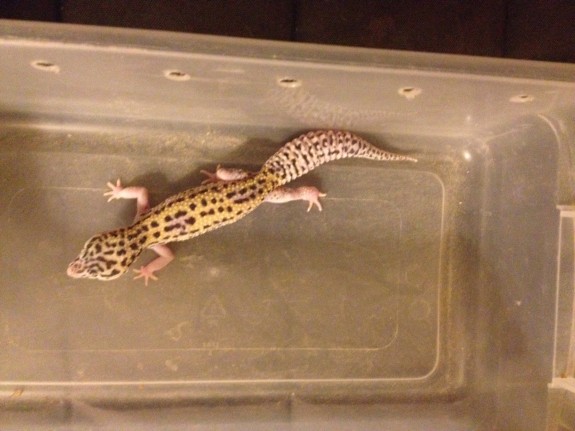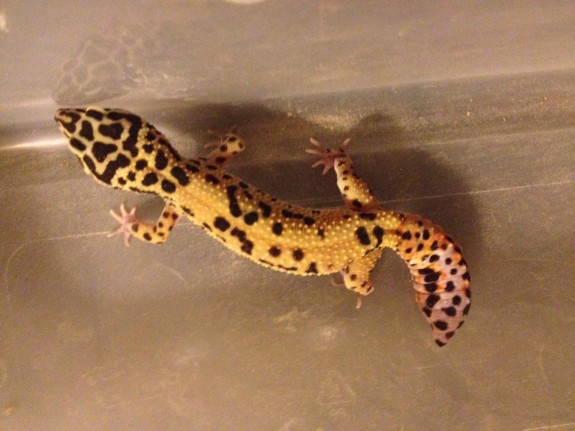As easy as it can be to put a male and female gecko together, stick the eggs in the incubator, wait for the hatchlings and raise them to adulthood, inevitably some of the hatchlings have problems. They’re born with deformities, they don’t eat, they don’t grow the way they should. This is meant to be a general guide to some types of problems that may occur and how to handle them. It is the result of my experience of 11 years as a leopard gecko breeder and nearly that amount of time as a breeder of several other gecko species.
Hatchlings can have problems for three reasons: obvious congenital deformities, non-obvious congenital deformities and improper husbandry. Sometimes the problem is due to a combination of these reasons. The most common problems that breeders encounter involve feeding and mobility.
Inappropriate Husbandry
Most gecko hatchlings have very similar needs to the adults of the species. They are, however, less hardy and less tolerant of non-ideal conditions. It’s crucial to insure that hatchling geckos have the correct temperature and humidity (some species may require slightly greater humidity than the adults so they don’t dehydrate). They need to feel secure in their enclosure and to be able to locate and ingest their food, which can be a problem if the enclosure is too large. Their food, if alive, needs to be an appropriate size for them and easy for them to catch. They will likely require feeding more frequently than the adults of the species. Husbandry is the first thing to check if hatchlings are having problems feeding or moving around.
Visible Deformities
Geckos can hatch with deformities for a variety of reasons including poor nutrition of the parents, genetic problems (due to extensive inbreeding or a gene for an abnormal trait), incubation problems (e.g. temperature fluctuations), or a random mutation. Visible abnormalities can include, but are not limited to: notched or missing eyelids in eyelid geckos, missing toes, limbs or parts of limbs, spine and tail deformities (kinks, stubby tails, scoliosis), abdominal hernias (opening in the abdomen causing the entrails to protrude), conjoined twins.
The first determination to make is whether the deformity allows the gecko to live a relatively normal, pain-free life. Geckos that hatch with no eyelids (for those species that have eyelids), or with severe abdominal hernias, will either die shortly after hatching or will experience severe pain and discomfort. These hatchlings should be put down humanely.
Hatchlings with less severe deformities, such as missing toes or slightly notched eyelids may be able to live a relatively “normal” life either unassisted or with some degree of assistance. Breeders have varying opinions about what to do about these hatchlings ranging from a policy of culling any hatchling with a deformity to raising them and giving them to those who will care for them.
Below is a list of some of the more common visible deformities and how to deal with them:
♦ abnormal eyelids: A hatchling with abnormal eyelids, which may include notching or partial absence, may be unable to close its eyes resulting in desiccation of the eyes and eventual blindness. Some of these hatchlings are able to improve the function of their eyelids as they grow. In order to insure that their eyes stay moist, dip your finger into clean water and transfer a drop of water to each eye. This needs to be done several times a day at first. If the eye develops crusty deposits, remove them gently. These hatchlings often need to be hand-fed at first because it seems that it’s hard for them to see. I’ve had considerable success with leopard gecko hatchlings with notched or partially missing eyelids that have learned to feed themselves and have required progressively less wetting of the eyes as they grew and matured.
♦ missing limbs or parts of limbs: If the hatchling is able to move from one place to another, this shouldn’t be more than a cosmetic problem. It’s more of an issue for arboreal geckos if the missing limb or digits prevents them from climbing. In that case a determination must be made about the gecko’s quality of life. If the gecko is able to climb but not to stick onto walls, an adapted cage which uses ramps and ledges to allow it to be safely arboreal may be a good solution.

♦ gait disturbances: I have hatched some geckos whose limbs look normal, but who appear to have difficulty walking normally.
♦ spine and tail deformities: In most cases this is not a problem unless the tail is so deformed that it’s getting in the gecko’s way. This could be a reason for a vet visit to amputate the tail. Some geckos hatch with a curved spine . It’s important to monitor them closely as they mature to insure that the condition is not progressive, and, if it is, that it isn’t interfering with their ability to move and breathe. If it does, they will need to be put down.
♦ blindness: Some geckos hatch without eyes. A blind gecko can have a reasonable quality of life if kept in a smaller than usual enclosure, taking care not to re-arrange the furniture. It will likely require hand-feeding at least at first, but may be able to locate feeders in a bowl by smell and function more independently.
♦ face and mouth deformities: Once again, a gecko with a significant underbite or overbite, cleft in the lip or other deformity needs to be assessed to determine if it will be able to ingest food even with assistance. If not the gecko needs to be put down. The gecko may require different sized food or food which is pureed and may need to be hand-fed for its entire life.
♦ prematurity or “small for dates”: Sometimes a gecko hatches out earlier than expected or much smaller than expected. Many of these geckos have yolk sacs attached. A gecko with an attached yolk sac should be placed on a non-particulate substrate and kept moist. In most cases, the yolk sac will dry up and fall off and the gecko will develop normally. Geckos that hatch unusually small with large yolk sacs may not survive due to being too small to eat and not having enough nutrition to make it through the early days. It may be worthwhile to try to feed them a puree “slurry” to give them some calories for growth, but there is no guarantee.

Non-visible Deformities
By far, the largest number of “problem hatchlings” falls into this group. These are the geckos that may look “fine” at hatching, but don’t eat, don’t grow and may look less and less “normal” as time goes by. Hang on till next week, when these issues will be addressed in Part 2.


Great Article! I just wanted to leave my input with two experiences I have had with hatchlings. I hatched out one mack snow with a spine that was pretty curved. I thought for sure this gecko would not make it but it did not seem to affect her movement or breathing. Turns out that this gecko ended up being one of my best eaters and is still doing great to this day. He is a pet now to a loving family!
The second experience was a mack snow bold stripe that hatched out just fine and had no visual deformities. He just never took to eating. No matter what I offered he would not eat. Tried the mealworm guts, gecko slurry, different feeders. Once he started weakening I had to cull him. Just thought it was weird how I thought the gecko with the visual deformities would most certainly die and the healthy looking gecko would make it. Turned out to be the opposite.
Thanks for sharing your stories.